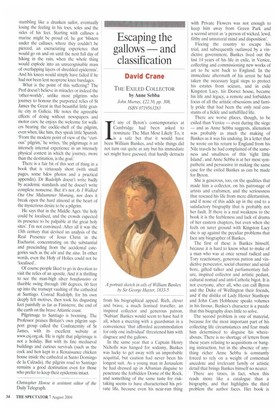Escaping the gallows — and classification
David Crane
THE EXILED COLLECTOR by Anne Sebba John Murray; £22.50, pp. 308, ISBN 0719563283 If any of Byron's contemporaries at Cambridge had been asked to nominate The Man Most Likely To, it is a safe bet that it would have been William Bankes, and while things did not turn out quite as any but his immediate set might have guessed, that hardly detracts
from his biographical appeal. Rich, clever and brave, a much lionised traveller, an inspired collector and generous patron, 'Nubian' Bankes would seem to have had it all, when a meeting with a guardsman in a convenience 'that afforded accommodation for only one individual' threatened him with disgrace and the gallows.
In the same year that a Captain Henry Nicholls was hanged for sodomy, Bankes was lucky to get away with an improbable acquittal, but caution had never been his longest suit. As a young man in Jerusalem he had dressed up in Albanian disguise to penetrate the forbidden Dome of the Rock, and something of the same taste for risktaking seems to have characterised his private life, because even his near-run thing with Private Flowers was not enough to keep him away from Green Park and a second arrest as 'a person of wicked, lewd, filthy and unnatural mind and disposition'.
Fleeing the country to escape his trial, and subsequently outlawed by a vindictive government, Bankes lived out the last 14 years of his life in exile, in Venice, collecting and commissioning new works of art to be sent back to England. In the immediate aftermath of his arrest he had taken the necessary legal steps to protect his estates from seizure, and in exile Kingston Lacy, his Dorset house, became his life and legacy, a remote and forbidden focus of all the artistic obsessions and family pride that had been the only real constants of a fickle and unfulfilled life.
There are worse places, though, to be exiled than Venice — even during the siege — and as Anne Sebba suggests, alienation was probably as much the making of Bankes as it was his undoing. In a letter that he wrote on his return to England from his Nile travels he had complained of the sameness and smallness of this 'tight little Island', and Anne Sebba is at her most sympathetic and persuasive in making the same case for the exiled Bankes as can be made for Byron.
She is generous, too, on the qualities that made him a collector, on his patronage of artists and craftsmen, and the seriousness that rescued his life from mere dilettantism, and if none of this adds up in the end to a satisfactory biography that is probably not her fault. If there is a real weakness to the book it is the feebleness and lack of drama of her eastern chapters, but even when she feels on surer ground with Kingston Lacy she is up against the peculiar problems that face any biographer of Bankes.
The first of these is Bankes himself, because it is hard to know what to make of a man who was at once sexual radical and Tory reactionary, generous patron and vindictive persecutor, social charmer and serial bore, gifted talker and parliamentary failure, inspired collector and artistic pedant, cultural nomad and anti-Catholic bigot. It is not everyone, after all, who can call Byron and the Duke of Wellington their friends, and if the dislike of Lady Hester Stanhope and John Cam Hobhouse speaks volumes in his favour, Bankes's character is a puzzle that this biography does little to solve.
The second problem is one of material, because for the most important part of his collecting life circumstances and fear made him determined to disguise his whereabouts. There is no shortage of letters from these years relating to acquisitions or hanging instruction, but in the absence of anything richer Anne Sebba is constantly forced to rely on a weight of contextual anecdote and irrelevant family or artistic detail that brings Bankes himself no nearer.
There are times, in fact, when this reads more like a catalogue than a biography, and that highlights the third problem the author faces. Her book is subtitled 'William Bankes and the Making of an English Country House'. Fair enough, in that it was, and is, his legacy. If it is the house readers want, though, they would be better off visiting it. If, on the other hand, it is the epigrapher and traveller who made an original and important contribution to Egyptology's most exciting age, they had much better stick to Patricia Usick's Adventures in Egypt and Nubia: the Travels of William John Bankes. And if it is Bankes the man? Then, on the evidence of this book, it would seem, sadly, that he is just going to have to be given up for lost.
David Crane's books include Lord Byron's Jackal: A Life of Edward John Trelawny and The Kindness of Sisters: Annabella Millbanke and the Destruction of the Byrons.



























































 Previous page
Previous page